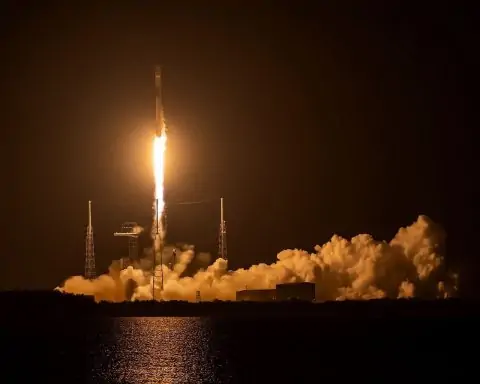Warsaw / Vandenberg, California – 27 November 2025
Poland will have to wait a little longer for its historic debut as a military space power. A Falcon 9 launch from Vandenberg Space Force Base in California, carrying Poland’s first military reconnaissance satellite and three accompanying defence nanosatellites, has been pushed back from Wednesday to Friday after a late scrub of the Transporter‑15 mission. [1]
Defense officials in Warsaw say the delay, likely linked to a fueling or other technical issue on the rocket side, does not threaten the mission but adds yet another twist to a launch campaign that has already slipped several times this month. [2]
Key facts at a glance
- New launch date: Friday, 28 November 2025
- Rocket & mission: SpaceX Falcon 9, Transporter‑15 rideshare flight
- Launch site: Space Launch Complex 4E, Vandenberg Space Force Base, California
- Planned time: 10:18 a.m. local (PST), corresponding to 19:18 in Poland [3]
- Polish payloads:
- MikroSAR – Poland’s first military synthetic‑aperture radar (SAR) satellite (ICEYE / PGZ programme)
- Three PIAST nanosatellites – part of the Polish ImAging SaTellites defence constellation
- PW6U – a research and commercial Earth‑observation nanosatellite from SatRev [4]
- Total payloads on Transporter‑15: roughly 140 satellites from multiple customers worldwide [5]
Falcon 9 launch scrub pushes Polish space debut back two days
On Wednesday, a Falcon 9 rocket was due to lift off from Vandenberg with more than a hundred small satellites on the Transporter‑15 rideshare mission, including Poland’s first dedicated military reconnaissance satellite. Roughly 15 minutes before liftoff, SpaceX called a halt to the countdown and scrubbed the attempt, citing technical reasons and opting to stand down for at least 48 hours. [6]
Poland’s Defence Minister and Deputy Prime Minister Władysław Kosiniak‑Kamysz confirmed on social media that the launch window has moved from Wednesday to Friday evening, Polish time. He urged the public to “be patient,” noting that safety takes precedence when dealing with such a complex mission and pointing to a likely fueling‑related issue behind the scrub. [7]
According to his statement, the next attempt is scheduled for Friday at 19:18 in Poland, aligning with SpaceX’s ride‑share window at 10:18 a.m. from California. [8]
Deputy Defence Minister Cezary Tomczyk underlined that the launch will place “Poland’s first reconnaissance satellite, MikroSAR,” into orbit as part of Transporter‑15, along with three PIAST nanosatellites and SatRev’s PW6U spacecraft. He described the mission as the first concrete step toward an indigenous satellite observation capability for the Polish Armed Forces. [9]
MikroSAR: the core of Poland’s new radar‑eye in the sky
At the heart of the mission is MikroSAR, the first satellite in a new radar imaging constellation commissioned by Poland’s Ministry of National Defence. Built by Finnish‑Polish company ICEYE in partnership with state‑owned defence group PGZ (through its subsidiary Military Communications Works No. 1), MikroSAR is designed to give Poland sovereign, all‑weather visibility over key regions of interest. [10]
Key technical and programme details:
- SAR capability: Synthetic‑aperture radar allows MikroSAR to capture detailed imagery day and night, regardless of cloud cover – a crucial advantage for defence planners operating in Europe’s often overcast conditions. [11]
- Resolution: ICEYE and Polish officials have highlighted imagery down to roughly 25 cm resolution, enabling the identification of small objects such as vehicles, artillery positions or temporary infrastructure. [12]
- Constellation scale: The MikroSAR programme, valued at around PLN 860 million (roughly USD 220–240 million), envisages three SAR satellites initially, with options for three more, creating a dedicated Polish radar constellation. [13]
From a military standpoint, such a system is far more than a symbolic achievement. Polish defence strategists repeatedly stress that high‑quality satellite imagery is essential to support “deep, precise strikes” and to guide long‑range weapons and artillery, as laid out in Poland’s modern deterrence doctrine. [14]
Until now, Warsaw has relied heavily on allied systems, including Italy’s COSMO‑SkyMed radar satellites and commercial imagery from foreign providers. MikroSAR gives the country an in‑house capability it controls end‑to‑end, from tasking to data processing. [15]
PIAST nanosatellites: a compact constellation for imaging and targeting
Sharing the Falcon 9 with MikroSAR are three PIAST nanosatellites, Poland’s first military imaging constellation in the 6U CubeSat class. PIAST – short for Polish ImAging SaTellites – has been developed by a domestic consortium led by the Military University of Technology in Warsaw, working with Creotech Instruments, the Space Research Centre of the Polish Academy of Sciences, the Łukasiewicz Research Network – Institute of Aviation, Scanway and PCO S.A. [16]
What PIAST brings to the table:
- Mission role: Optical and electronic‑imaging reconnaissance in support of the armed forces, complementing the radar coverage provided by MikroSAR. [17]
- Intended use: Planning and coordinating troop movements, assessing damage, tracking armour and artillery, and providing targeting data for long‑range precision munitions. [18]
- Programme value: About PLN 70 million (around USD 18–20 million), funded in part through Poland’s National Centre for Research and Development. [19]
While each PIAST satellite is far smaller than a traditional spy satellite, the constellation approach – multiple small spacecraft working together – allows for more frequent revisits over the same area and increases resilience: losing one satellite does not cripple the system.
PW6U: SatRev’s high‑tech nanosatellite joins the ride
Transporter‑15 will also loft PW6U, an advanced 6U Earth‑observation nanosatellite developed by Polish company SatRev in Wrocław. PW6U is equipped with a multispectral optical payload (covering visible and near‑infrared bands) and onboard AI‑based data‑processing systems. [20]
According to company materials, the satellite is designed to support applications such as: [21]
- Environmental and climate monitoring
- Precision agriculture and forestry
- Infrastructure and energy‑asset inspection
- Coastal, maritime and critical‑infrastructure surveillance
Although PW6U is not a pure military asset, it fits neatly into a broader pattern: Poland is nurturing a dual‑use space ecosystem, where satellites can serve both defence and civilian customers, from ministries to commercial data buyers.
A launch that keeps slipping: from 11 November to 28 November
Thursday’s postponement is just the latest in a sequence of delays that have pushed Poland’s military satellite launch further into November:
- Original plan – 11 November 2025:
The launch was initially scheduled to coincide with Polish Independence Day, a highly symbolic date. The satellites were to fly on a SpaceX Falcon 9 as part of Transporter‑15 from Vandenberg. [22] - First delay – rescheduled to 22 November:
In early November, Poland’s General Staff announced that the launch would slip to 22 November, following notification from SpaceX. No detailed reason was given, other than standard scheduling and technical considerations. [23] - Second delay – targeting 26 November:
Subsequent updates from Polish and international space media showed Transporter‑15 retargeted to Wednesday, 26 November, with Poland’s satellites still on board. [24] - Current status – launch scrubbed, new date 28 November:
On Wednesday, SpaceX scrubbed the attempt roughly a quarter of an hour before liftoff, then announced a new target of Friday, 28 November, during the same 10:18 a.m. PST window. Both SpaceX and Polish officials have emphasized that the rocket and payloads remain healthy. [25]
Launch delays of this kind are common in the space industry, particularly for complex rideshare missions carrying dozens or even hundreds of satellites. Transporter‑15 is expected to deploy around 140 payloads from multiple companies and agencies, with rideshare specialist Exolaunch handling the release of 59 of them. [26]
Why this mission matters for Poland – and for NATO
The postponement may be inconvenient, but it does not change the strategic picture. Poland is on the verge of joining the small but influential club of countries operating their own military reconnaissance satellites, rather than relying solely on allies or commercial imagery.
Several broader trends underline the importance of Friday’s launch:
- Lessons from the war in Ukraine:
The full‑scale Russian invasion of Ukraine has shown how critical space‑based intelligence is for modern warfare. High‑resolution imagery and SAR data have been central to Ukraine’s ability to track Russian forces, plan artillery strikes and monitor border regions. Polish officials explicitly cite the war as a catalyst for accelerating their satellite programmes. [27] - Deterrence and long‑range strike:
In Polish doctrine, satellites like MikroSAR and PIAST are designed to serve as the “eyes” that guide long‑range precision weapons and deep‑strike capabilities – a key pillar of deterrence against any potential aggressor. [28] - Building a domestic space‑industry base:
With ICEYE, Creotech, SatRev and multiple research institutes heavily involved, the programme keeps a large part of the technology chain – from satellite bus and payload to ground segment and data analytics – inside Poland. That reduces dependence on foreign suppliers and creates high‑tech jobs at home. [29] - European and transatlantic cooperation:
Beyond MikroSAR and PIAST, Poland has also ordered two high‑resolution optical satellites from Airbus as part of a French‑Polish orbital system, due to be launched by 2027 under a contract worth around €575 million. Those spacecraft will further integrate Poland into European and NATO intelligence networks. [30]
Taken together, MikroSAR, PIAST and PW6U signal that Poland is moving rapidly from being a consumer of allied space services to a contributor of its own imagery and data.
What happens next
As of the afternoon of 27 November 2025, all eyes are on Friday’s launch window:
- If Transporter‑15 lifts off on schedule, MikroSAR, the three PIAST satellites and PW6U should be deployed into a sun‑synchronous orbit within a couple of hours of launch, joining a cluster of international payloads. [31]
- After in‑orbit checkout, the Polish Ministry of National Defence will progressively bring the system into service, feeding data to the Geospatial Intelligence and Satellite Services Agency, the military body established to process satellite imagery and deliver products to commanders. [32]
- Commercial users – particularly in agriculture, energy, insurance and environmental monitoring – are also expected to benefit from the growing flow of radar and optical data from Polish‑built satellites. [33]
For now, the story is one of short‑term delay, long‑term transformation. A two‑day slip in the launch schedule does little to dim the significance of what is about to happen: once MikroSAR and its companion satellites reach orbit, Poland will have taken a decisive step into the era of sovereign military space capability.
References
1. www.polskieradio.pl, 2. www.polskieradio.pl, 3. spaceflightnow.com, 4. www.polskieradio.pl, 5. spaceflightnow.com, 6. spaceflightnow.com, 7. www.polskieradio.pl, 8. www.polskieradio.pl, 9. www.polskieradio.pl, 10. orbitaltoday.com, 11. orbitaltoday.com, 12. orbitaltoday.com, 13. orbitaltoday.com, 14. www.defensenews.com, 15. caliber.az, 16. caliber.az, 17. caliber.az, 18. en.wikipedia.org, 19. caliber.az, 20. wbj.pl, 21. successful-investing-in-poland.com, 22. menafn.com, 23. www.polskieradio.pl, 24. spaceflightnow.com, 25. spaceflightnow.com, 26. spaceflightnow.com, 27. orbitaltoday.com, 28. www.defensenews.com, 29. orbitaltoday.com, 30. www.defensenews.com, 31. spaceflightnow.com, 32. www.defensenews.com, 33. successful-investing-in-poland.com










